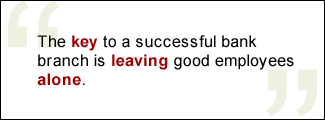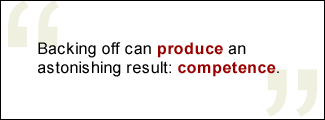John Richards was not the kind of customer banks love. For a decade, he's had a checking account at a big national bank, call it "A-One," in a Midwestern city -- but only because they have a branch next to his office. Richards' certificates of deposit were at one credit union; his car loan was at another. He had a credit card through another bank. And he went to a small, locally owned bank for his mortgage.
 |
When Richards bought a new house, he checked the mortgage rates at A-One only because it was one of the few branches in his new hometown; an online home-loan company was next on his list. But when he walked out of the A-One branch location in his new hometown, Richards suddenly felt like royalty. "I've never been treated so well in my life," Richards says. "The bank president helped me get the loan and set me up with an investment advisor who scheduled time to talk to me about when my CDs are due. It used to take me 15 minutes to talk to an A-One teller at the last branch."
By the time Richards got the key to his new house, he had eight products with A-One Bank -- a mortgage, a line of credit, two checking accounts, two savings accounts, a credit card, and an online banking account. And soon, he will be talking with the investment advisor about those CDs.
Richards is in his mid-thirties -- there will be a lot of mortgages, car loans, savings accounts, and investments in his future. Thus, we can suppose that the behavior of a few people at one A-One branch location has ensured the bank of an awful lot of business for decades to come -- not to mention the new customers that Richards will steer toward the branch. But how did one small branch make him an engaged customer when another, much larger, branch of the same bank couldn't do it in a decade? Why, after a 10-year relationship, did Richards finally fall in love with A-One Bank?
The conundrum
Banks continue to wrestle with questions like these. A study by Booz Allen Hamilton, for example, found that 79% of European banking customers would rather buy checking and savings account products from a branch than from other sales channels. That's why smart financial institutions work so hard to make their branch locations appealing -- by offering a plethora of services, mandating actionable steps for employees, and even going so far as to make the interior decoration identical from location to location. Yet variation in service levels among branch locations can be immense. It's not uncommon for one branch location to vastly outsell and outservice a sibling branch only blocks away -- while creating engaged customer relationships -- seemingly without effort. This drives bank executives crazy.
There is a reason for the variation, of course. Some branch locations are better at customer service than others, and leaders of financial institutions must look past the décor, the training programs, the steps, and the mission statement to find out why. The answer to the bank variation conundrum lies with the people behind the desks and counters -- and the answer is not one bit replicable.
 |
No more steps!
A bank branch can reach peak profitability only if it engages customers. To do that, the branch has to find and hire people who have a talent for the job and who actively work to engage customers, then keep them engaged. Relatively speaking, finding the employees may be the easy part. The last part is the hardest -- the key to a successful bank branch is leaving good employees alone.
Many banking executives look to systemic, actionable steps to create cost-saving efficiencies and face-saving behaviors. They try mightily to make every bank branch the same to alleviate, or perhaps even eliminate, differences that can't be controlled and that can cause problems. But an overimplementation of efficiencies and steps ties bank employees' hands and can make it impossible for them to serve individuals, well, individually. And treating each customer the way he or she wants to be treated is how banks create engaged customer relationships.
So how can bank executives learn to back off to develop more profitable branches? How can they eliminate "bad" variation in service to foster healthy individuality? Here are some key actions that executives and managers can take:
- Speak with painstaking clarity about what the customer experience should feel like.
- Be relentlessly consistent in your coaching. Have daily conversations about the customer experience, and celebrate the successes that win customers over.
- Never tire of describing the outcomes you want -- but let employees figure out how to get there.
- Above all, fight the urge to put in more actionable steps. They create robotic (and unhappy) frontline staff. Robots don't create an environment that grows emotional engagement.
The best people to determine what needs to be done in a bank branch are the people who work there six days a week. The branch manager knows how persnickety Mr. Smith likes to be served as a customer, and she knows which employee on her team helps Mr. Smith best. The frontline staff knows if bilingual tellers need to be added or if paperwork takes time that would be better spent with customers. Freeing bank employees to do what they need to do permits them to focus on growing relationships with customers, which is key to growing the bank's business.
 |
Much of the work of a bank must be done by rote -- vault audits, for example -- but customer engagement is intensely personal and human. Banks must let the people who know best do their best. That's because backing off -- as long as senior managers are clear about the outcomes they want -- can produce an astonishing result: competence.
John Richards is now settled in his new home in his new town. Twice a month, he sees the president of his bank, who encouraged him to join a local club -- and was even his sponsor. "I had no idea how much easier a good bank can make your financial life," Richards says.
Clearly, Richards was both a victim and a victor of bank branch variation. With a little less stress on steps and a little more on outcomes -- and a lot less stress for the customer -- the branch he abandoned might become one he'd go back to.